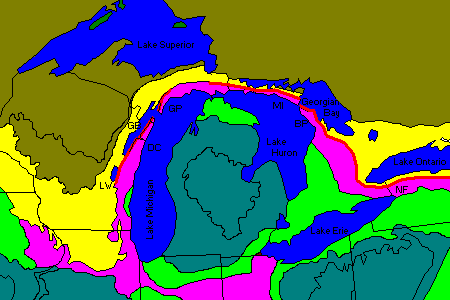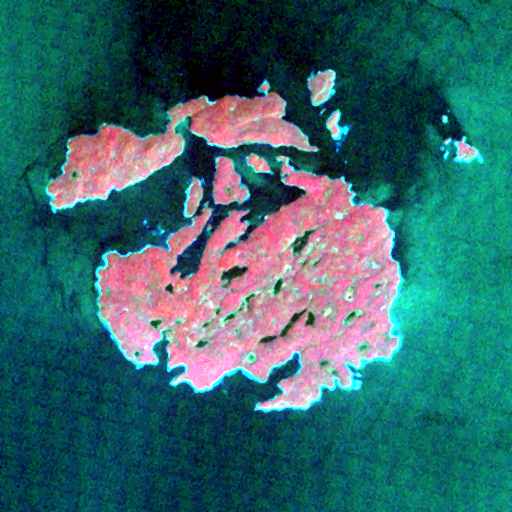STORY LINKS
Front Page
Wright is Wrong
Mystery Airship
Killer Cougars
Giant Rabbits
Michigan Caves?
Islands from Space!
Flying Squirrels
Bogus Archeology
Gold in the River!
Michigan's Cactus
Foolish Fire
Pileated Woodpecker
Questions, comments, submissions, & advertising
Contact BPP
|

 Michigan Chronoscope - Stories on the fringe of history
Michigan Chronoscope - Stories on the fringe of history
Chronograph Numeral I - Autumn 2004 - Page Four
|
Caves in Michigan?
 Pink and red areas indicate the location of the Niagara Escarpment
Pink and red areas indicate the location of the Niagara Escarpment
It doesn't seem likely that there would be caves in Michigan, but there are caves! Although few in our state, caves are not unknown in the region. In fact, Michigan caves have some interesting history associated with them.
A cave is formed by water seeping into the cracks of limestone bedrock. Water in the soil picks up carbonic acid that eats up softer layers of limestone it passes through. After countless years the water creates sinkholes, underground streams, and caves. This combination of formations is called "karst" terrain and can be found in the Great Lakes region due to a geologic formation called the "Niagara Escarpment".
The Niagara Escarpment is the edge of a thick series of dolomite limestone layers. The rocks are resistant to erosion and stand as a prominent line of bluffs. The ridge runs around the west side of Lake Michigan north into Door County, Wisconsin, over to the Garden Peninsula of Michigan's Upper Peninsula, to Mackinaw, Drummond, and Manitoulin Island, then the Bruce Peninsula in Ontario Canada. From there the Escarpment goes southeast across Ontario and into New York, where it creates Niagara Falls. It's along this escarpment where many caves can be found.
Although every Michigan cave claims to be the only one, there are a number of them, some of which are open to the public. Bear Cave, downstate in Buchanan, is open to the public. It is not a karst cave, but a much rarer "tufa" cave. It has stalactites, flowstone, petrified leaves, and other strange shapes, all colored by metal oxides. In 1875, the loot from an Ohio bank robbery was hidden in this cave. Inspired by this event, it was featured in the 1903 movie The Great Train Robbery now considered a silent film classic. The cave is entered through the gift shop.
Skull Cave on Mackinac Island is a karst type of cave found on the Niagara Escarpment. According to tradition, this is the cave in which the English fur trader Alexander Henry hid during the Indian uprising of 1763. He claimed the floor of the cave was covered with human bones. Possibly it was once used as an Indian burial.
Burnt Bluff Cave, A.K.A. Spider Cave, in Delta County (in the U.P.), has some Indian pictographs (rock drawings) associated with it. This site is located on private property, and the pictographs appear at the base of a 140-foot limestone cliff on Big Bay De Noc of Lake Michigan. The small cave is thought to have been used in some rituals. Over 100 projectile points were discovered in Spider Cave, all with broken tips, suggesting they were thrown into the cave.
The 480-acre Fiborn Karst Preserve in Michigan's upper peninsula is owned by the Michigan Karst Conservancy. It includes an extensive karst drainage system with features such as sinkholes, caves, and disappearing streams.
In eastern Alpena & Presque Isle Counties, exposed limestone bedrock is common and karst depressions or sinkholes can be found in the Rockport area. The 31-acre Stevens Twin Sinks Preserve west of Alpena, purchased in 1990 by the MKC, contains examples of sinkhole habitats
There are also underwater "caves" in the lakes. The Alger Underwater Preserve offers two main diving attractions: shipwrecks and sea "caves". The sea caves are portions of underwater sandstone cliffs where the softer sandstone has been eroded away by waves. Other "sea caves" are found along the Pictured Rocks National Lakeshore. The caves are found in water 20 feet deep or less. The Thumb Area Underwater Preserve has caves created by eroded limestone. The caves are located near the edge of the reef near Port Austin Lighthouse.
Comment about this article on the
Epress Forum Board
.
|
|
Islands From Outer Space!
 Could these islands have alien life?
Could these islands have alien life?
Unbelievable as it may be, there is a group of islands in the Great Lakes that aren't from this world. The Slate Islands near the top of Lake Superior, south of Terrace Bay Ontario, are seventeen islands that many scientists believe to be the product of an impact crater.
A staff scientist at NASA's Lunar and Planetary Institute claims the meteor that created the Slate Islands was about 20 miles in diameter. Studies indicate that the asteroid entered 2 miles deep inside the earth and has a 30' wide shatter cone. Shatter cones are found around sites of nuclear explosions but are only about an inch deep. The shatter cone on Slate Island may be the world's largest! Traveling at up to 12 miles per second, it vaporized in a blast equal to more than one million tons of TNT. The atomic bomb dropped on Hiroshima generated the amount of energy of only 15 thousand tons of TNT.
The size and speed of this asteroid put it in the category of a "dinosaur killer". Popular dinosaur extinction theories claim that the impact of a large asteroid caused a "nuclear winter" that wiped out most of the life on Earth and caused the extinction of the dinosaurs. The theory claims that a single high-velocity asteroid impact in an area now covered by the Gulf of Mexico was to blame. Estimates of the age of the Slate Island crater range from 350-450 million years old and the mass extinction of the dinosaurs is thought to have occurred around 65 million years ago. Given these age estimates, the Slate Island event happened well before the age of the dinosaurs (claimed to have begun around 200 million years ago).
Outside of the incredible destructive power of meteor impacts, there is the notion that extra-terrestrial life inside the meteor may survive the impact. If the debate surrounding the Martian meteorite found in Antarctica (known as # ALH84001) shows that ancient Martian microbes may have survived the trip, what if they had 450 million years to adapt to our environment? I can imagine such a science fiction scenario occurring on the Slate Islands. A remote and mysterious island, lost in time and space, harboring strange alien life forms hidden in unearthly caverns. Dangerous and forbidding, it lures adventurers and treasure hunters looking to exploit its vast riches.
Other than harboring aliens, the rest of that last statement is basically true. The Slate Islands are remote, accessible only by plane or boat. The vast riches come not only in the form of gold and other precious minerals deposited by the meteorite but in the knowledge gained from studying a large crater here on Earth. Today it is part of the Provincial Park System of Canada and cannot be mined or exploited by adventurers but it can be visited for camping and fishing.
Comment about this article on the
Epress Forum Board
.

|
|
|
Keywords: Michigan, Great Lakes, history, amazing, astonishing, baffling, bizarre, cryptic, curious, different, extraordinary, forgotten, hidden, incredible, inexplicable, legends, lore, lost, myths, obscure, odd, peculiar, rare, stories, strange, surprising, tales, unexplained, unfamiliar, unique, unknown, unusual, weird
|
|



